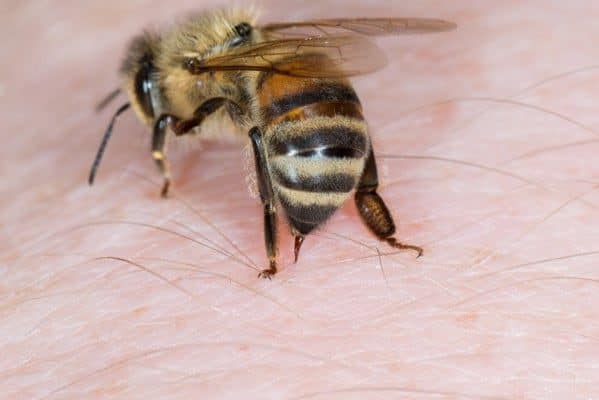One of the common things we hear about bees is that they can smell fear. We know that going near a beehive isn’t very safe, but should people who are afraid of bees control their emotions when they encounter a bee? Can bees smell fear?

Bees cannot smell fear because fear is an emotion that arises with the threat of harm. It does not have an odor. However, bees consider sudden movements and certain odors dangerous. As soon as they feel threatened, they will signal the other bees through movement or by releasing pheromones.
The rest of this article will explain a few topics related to this question, including how bees communicate with other bees, how bees smell, and how you can avoid a bee attack.
Why are we told bees can smell fear?
Bees, in general, are harmless. However, they will sting you if you come off as a threat and disturb them.

When humans encounter bees, the most common instinct of humans will be to move erratically and slap the bees. This aggressive behavior will cause the bees to feel threatened. As a result, they will fly at you and sting you.
Since bees usually attack people who are scared, it is natural for you to think that bees can smell fear. Bees cannot smell fear, but they can sense the reactions that arise due to fear.
How do bees communicate with other bees?
A single bee colony could consist of more than 10,000 bees. And an easy communication method is important for the proper functioning of the colony. Imagine if they can all speak as humans can. It would drive them crazy.
Bees depend on body movements and pheromones to communicate with other bees. Body movements are used to communicate within small groups of bees, whereas pheromones can pass on messages to the whole beehive.
If you want to know more about “How bees communicate”, click on the link, to this article where we take a deep dive into the topic.
Movement
Body movements are simply physical behaviors used to communicate within small groups of bees. The direction of the movement, the duration of the movement, and even the vibrations of their body during movement contribute a lot to the message to be conveyed.
Bees commonly use two kinds of movements for communication: the waggle dance and the vibration dance.
Waggle Dance
Bees use waggle dance to tell the other bees where the nectar and pollen-rich flowers are.
In waggle dance, the direction the bee moves in relation to the hive indicates which way to go to reach the pollen-rich flowers. The duration of the waggle part of the dance is adjusted to convey the distance from the beehive to the destination.
The Vibration Dance
Just like the name, vibration dance is all about the vibrations caused by body movements. Bees in the hive vibrate their body, which then transmits through the wax combs. Vibration dance indicates that it is time to increase the foraging activity as resources are falling short in the beehive.
Odor
Communicating with a chemical smell is sophisticated bees specialize in this process. They use their exocrine glands to secrete substances called pheromones to communicate with each other.
Pheromone is a chemical substance produced by animals or insects, which when released into the environment, trigger behavioral and physiological responses in other animals of the same species.
There are mainly two kinds of pheromones: primer pheromones and releaser pheromones.
Primer pheromones trigger physiological responses that will stay long-term. Queen bees use primer pheromones to tell all other bees that she is healthy. This encourages all the other bees to forage for nectar and pollen, and stay productive.
Release pheromones generally have a weaker effect. It only impacts the behavior of the bees. For instance, these pheromones are used to tell the bees that they are in trouble. Upon receiving this signal, the bees get ready to fight the predator and protect the hive.
How do honey bees smell?
Honey bees use olfactory organs present in their antennae to detect odor. These organs are extremely sensitive to smell. As a result, the bees can detect the scent of a food source that is two miles away.
Since their olfactory organ is hypersensitive, they can assess the food, without even going near it. While flying, they pick up scents and debate if the food source is good. Bees are experts at finding pollen-rich flowers, and this is why.
The National Institute of Health conducted a study in bees and published it in the Genome Research. The study revealed that bees have a total of 170 odor receptors, and their sensitivity to scent is 50 times more than that of a dog.
Bee antennae are really amazing. We have a whole article the looks at bee antennae if you are interested? It’s called, Bee Antennae, An Amazing Sensory Super Highway
What scent do bees hate?
While bees are naturally attracted to smells of fruit and honey, there are certain scents that bees absolutely hate. These include fragrances of peppermint, eucalyptus, and spearmint. They also deter scents of lavender oil, olive oil, and vegetable oil.
If there is a bee infestation near your home, you can make a bee spray to keep them away.
Make your own bee repellent
- Combine 3 teaspoons of liquid soap with water
- Add a few drops of peppermint oil to this mixture. Most bees deter the scent of peppermint, and this will keep them away.
- Add a one-quarter teaspoon of cinnamon to strengthen the deterring smell.
- Spray this mixture near the areas of bee infestation.
Repellents are always better than traps. Bees are an essential part of our ecosystem. Hence, use bee infestation control methods that do not involve killing of bees.
How can you avoid a bee attack?
The most practical way to avoid a bee attack is to leave them alone. Bees will sting you only if they feel threatened, and as long as you do not go near them and disturb their nest, they will not attack you.
Here are a few actionable steps you can take to avoid bee attacks:
- Wear long-sleeve shirts and long pants
Whenever you are going near a beehive, wear clothes that cover your whole body. It is also advised to wear a hat. Wear high boots and gloves. Tuck your pants into the boots and your sleeves into your gloves.
It is possible for bees to sting through clothes. But heavy and layered clothes will greatly reduce the impact of the sting.
- Be alert
As soon as bees feel unsafe because of your presence, they will try to bump you into a few times to make sure that your intention is to harm them. Look out for this kind of action while you are near beehives. If you get this warning, move to another location immediately.
- Do not swat
If a bee buzzes and flies at you, your natural instinct would be to swat at them aggressively using both hands. But the truth is, sudden movements will encourage the bees to attack and sting you. Although you are just flapping your hands out of fear, the bees will feel that you are a threat to them.
If things get out of hand and the attack begins, do the following:
- Cover your head and face
Bees are drawn towards attacking the head of the predator. Therefore, cover your head and face as soon as the bees start attacking you.
- Run
If you sense that the bees are coming towards you, run away from the place as fast as you can. Make use of the athlete in you and run for your life.
- Get indoors
Try to get indoors or any other enclosed space where the bees cannot follow you. For example, once you safely get in a car, the bees will not be able to enter inside. Never jump into a water body to escape bees. They will just wait for you to surface.
The Wrap Up
Honey bees are popular for their sophisticated communication systems that use pheromones, but contrary to popular belief, bees cannot smell fear. However, they are sensitive to movements and aggressive behavior, and will attack you if they feel unsafe.
The best way to avoid a bee attack is to stay away from their nests. Even when a bee bumps into you, just walk away from the place. Do not swat at them or flap your arms.
Stinging humans is in a way, suicide for most species of bees. When a bee stings, it cannot pull out the stinger. A part of its digestive system also comes out. This abdominal rupture will cause the bee to die.
Bees make excellent pollinators and are vital for the maintenance of ecological balance. Therefore, it is always better to leave them undisturbed and promote their well-being.
References
https://www.kelleybees.com/blog/news-events/understanding-how-honey-bees-communicate/
https://www.ncbi.nlm.nih.gov/books/NBK200983/
https://honeybeehq.com/how-do-bees-communicate/
https://beekeepercenter.com/can-bees-smell/
https://beekeepercenter.com/can-bees-smell-2/
